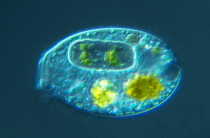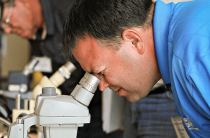The situation when a woman, being in a state of pregnancy, suffers from allergic diseases, today, alas, is not uncommon. In modern large cities, a large number of adverse environmental factors that irritate the immune system and provoke it to the manifestation of allergic reactions. During pregnancy, the unborn child may suffer from the improper use of drugs ...
For this reason, the treatment of allergies occurring during pregnancy requires a careful approach to the selection of drug therapy. After all, many drugs that do not cause side effects in ordinary people have a negative impact on the health and development of a child in the womb.
A woman may experience an allergic reaction for the first time during pregnancy. Basically, this is due to the fact that the body only adapts to pregnancy for the first 10-14 weeks of life, and at this time the mother's immunity does not know how to respond to the usual stimuli. This leads to many unusual, for a woman, conditions, in particular, allergic manifestations.
Many women who suffer from allergic reactions are apprehensive about pregnancy. Particularly desperate even think about not becoming a mother at all. Such a position on this issue is fundamentally erroneous. For such frightened women, doctors have two good news: the first news is that in the modern world there are drugs that show a high degree of safety in the treatment of allergic diseases; the second news is that during pregnancy, the symptoms may decrease or disappear completely.
This happens because pregnancy is a stressful condition for a woman's body. Any stress in a person turns into the production of a hormone called cortisol. Cortisol is a hormone that helps our body cope with stress. It is also used to control inflammatory and allergic reactions, reducing their intensity. This leads to the fact that the manifestations of allergies are eliminated in a pregnant woman.
Why is allergy dangerous for a child?
First, it has been established that allergy is a disease that is inherited. If the mother suffers from allergies, then there is a 40% chance that the child will also be allergic. Alas, it is impossible to predict the nature of an allergy in an unborn child, since with hereditary transmission in a child, the risk of an allergic predisposition increases, in the development of immunity. Secondly, during an allergy, nervous disorders often appear, as well as a general deterioration in the well-being of a pregnant woman, which are undesirable changes for the baby in the mother's condition.
A common cause of the development of allergic reactions is the wrong attitude to hygiene on the part of parents. We are talking about a situation where the parents of the child pay pathological attention to the hygiene of the child, as well as excessive sterilization of living conditions. Too frequent bathing of the child, constant washing of already clean things, almost daily change of bed linen and incessant cleaning play not a positive, but, on the contrary, a negative role for the health of the child. Although it sounds paradoxical, but excessive cleanliness weakens the immune system and interferes with its normal development. This happens because for the adequate functioning of the immune system, the baby's body needs contact with the factors it is aimed at combating. Excessively caring parents, on the other hand, protect the baby not from germs, but from healthy immunity, which knows how to properly respond to adverse environmental factors.
It is also worth considering that hygiene procedures are carried out using various household chemicals that negatively affect the child's body. The children's body is very sensitive to the effects of provoking chemical agents. Often, children who wash their clothes too often develop skin rashes, sneezing, and nasal congestion.
Infectious diseases that a child suffers in childhood adversely affect the formation of immunity. It is necessary to pay attention to prevention and timely vaccination. It is especially necessary to carefully monitor the respiratory situation in children's institutions, since a large concentration of children contributes to the immediate spread of infections. When out and about, dress your child appropriately for the weather to prevent both hypothermia and infection-promoting sweating in the slightest wind or draft. By the way, about drafts, it is necessary to pay special attention to the elimination of their sources, since drafts contribute to local hypothermia, against which various inflammatory and infectious reactions develop.
Food allergies also often manifest themselves in childhood. This is due to the wrong transition to natural nutrition, at the end of breastfeeding. The wrong approach to the introduction of natural complementary foods leads to attacks of childhood diathesis, which is characterized by the formation of a localized accumulation of ulcers, with flowing colorless or purulent contents, constant itching and redness. To avoid this, the transition to eating natural foods for a child should occur smoothly. Even products such as low-allergenic vegetables and gluten-free cereals should be introduced not only at the right time, but also gradually, starting with minimal dosages.
Allergy symptoms in pregnant women
Allergy is a disturbed state of the normal functioning of the body's defenses, in relation to certain components of the external or internal environment. These triggers are called allergens. The difference between allergens and such harmful factors as parasites or toxic agents is that, as such, they do not pose a danger to the body and are calmly tolerated by people who do not suffer from allergies.
Allergy symptoms during pregnancy
Pregnancy does not affect the variety of allergy symptoms; in general, the following groups of symptom complexes can be distinguished:
- Allergic dermatitis. This allergy symptom is characterized by the appearance of foci of an allergic reaction on the skin, which are expressed by the formation of ulcers and vesicles filled with a transparent or cloudy yellow secret. The area where the dermatitis appears is constantly reminded of itself by itching. This form of an allergic reaction is typical for food allergies, drug allergies, as well as contact allergies, in which the effect of the substance occurs directly on the skin. In this case, the localization of the reaction occurs at the point of contact.
- Urticaria is an allergic rash that looks like red or pink chemical burns. There is an acute form of urticaria in which the symptoms spread rapidly, covering the entire body. In places where urticaria appears, the local body temperature rises.
- Conjunctivitis. With allergies, the manifestations of conjunctivitis include: inflammation of the eyes and skin around them, increased tearfulness, eye irritation from light, swelling of the eyelids;
- Rhinitis. During allergic reactions, rhinitis is expressed by the expansion of the sinuses, an increase in local blood vessels, a constant runny nose, sneezing and itching of the nose.
- Bronchial asthma is, together with allergic rhinitis and conjunctivitis, the most common occurrence when allergens are inhaled. Like ordinary bronchial asthma, allergic asthma is manifested by a dry cough, bronchial constriction, which causes breathing problems, as well as wheezing when air is absorbed and a feeling of compression in the chest. Bronchial asthma is dangerous for the child, because it threatens with fetal hypoxia and must be eliminated with the utmost haste.
- Anaphylactic shock is another severe type of allergic reaction. This symptom of allergy is characterized by a critical decrease in blood pressure, the development of edema and spasm of the muscles of the larynx, which leads to a delay in breathing. A potentially dangerous condition that carries a direct risk of death. Due to anaphylactic shock, skin and provocative allergy diagnostic methods are not performed in pregnant women, since they involve direct contact with the allergen.
Allergy treatment during pregnancy
Today, medicine has in its arsenal a wide range of tools designed to combat allergies. Pregnancy is a special state of the body that requires attention not only to the health of the mother, but also to the health of the fetus. Means that are selected for the treatment of allergies during pregnancy should have a high degree of safety for the fetus, and should not affect the course of pregnancy.
Antihistamines during pregnancy
Antihistamines, which are used to treat allergies in a patient, in the normal state during pregnancy have a number of contraindications associated with the ability of some drugs of this class to affect the fetus, as well as the course of pregnancy. It should be noted that the use of any antihistamines has a risk of side effects, which include:
- Depression of the central nervous system, which occurs as a result of high infiltration of active substances into the brain. This is manifested by drowsiness during the day, weakness, confusion and lethargy.
- Violation of the cardiovascular system, which manifests itself as a consequence of the effect of antihistamines on the work of potassium, inside the heart muscle;
- Increase in the frequency and strength of heart contractions;
- dry mouth;
- Violation of the normal functioning of the gastrointestinal tract.
These side effects can cause a deterioration in the general well-being of the mother during pregnancy, which is unacceptable. For this reason, systemic antihistamines in the form of tablets are used only when it is impossible to use forms for topical use (drops, sprays).
Such a popular antihistamine as demidrol has a negative effect on the course of pregnancy, because it causes the activity of the muscles of the uterus, which is a direct threat of miscarriage.
Astemizole, previously used to treat chronic allergic reactions, showed the ability to cause severe cardiac arrhythmias during use, resulting in cases of death. It is not used to treat allergic reactions in pregnant women, as well as due to the toxic effect on the fetus.
Diazolin is not recommended for the treatment of allergic manifestations in pregnant women, since under its influence negative processes are observed during the formation of the child's central nervous system.
Tavegil - is not used in the first trimester, because it negatively affects the formation of tissues in the fetus during this period. The rest of the time it is used only in case of emergency.
Azelastine - is not used during pregnancy, because it has the ability to cause dystrophy in the fetus, as a result of which the child may be born prematurely.
The remaining funds are used with great care, only if there are indications for use, as a result of which the danger to the mother and fetus, without their use, is higher than with their use.
Local remedies for allergies during pregnancy
Local remedies are represented by drops and sprays for the eyes, drops for the nose, ointments, creams and gels for external use. The drugs contained in these forms are safer, since the active ingredients penetrate the body much worse, beyond the place of direct use. This means they have minimal impact on overall health.
However, some substances are still capable of accumulation, so it is necessary to use them as little as possible and for a short time to avoid unwanted side effects.
Means of preventing allergies during pregnancy
- Do not expose skin to direct contact with solar radiation. If there is a need for a daytime walk, then try to be in the shade as much as possible;
- Carry out wet cleaning as often as possible;
- During pregnancy, leave pets and birds in the care of acquaintances, as their hair and feathers contain potential allergens;
- Do not walk in dry and windy weather, because at this time the maximum concentration of pollen and dust allergens;
- Refrain from eating previously unknown products;
- Stay away from hives. Hymenoptera insect bites (bees, wasps, hornets, etc.) have severe consequences, up to anaphylactic shock;
- Follow a special hypoallergenic diet















